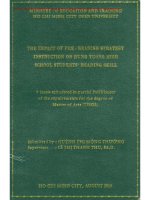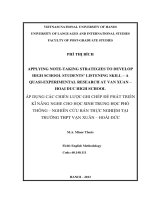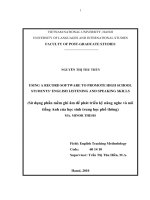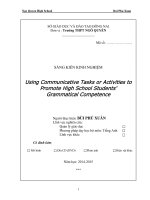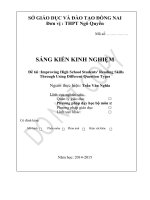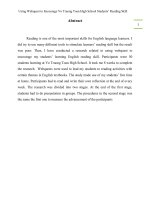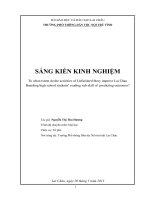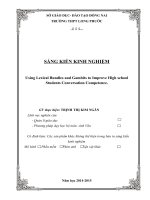Using Barrett’s Taxonomy to Enhance High School Students’Reading Comprehension
Bạn đang xem bản rút gọn của tài liệu. Xem và tải ngay bản đầy đủ của tài liệu tại đây (165.21 KB, 12 trang )
SỞ GIÁO DỤC VÀ ĐÀO TẠO ĐỒNG NAI
Đơn vị : THPT Ngô Quyền
___________________
Mã số: …………………..
SÁNG KIẾN KINH NGHIỆM
Người thực hiện: Trần Văn Nghĩa
Lĩnh vực nghiên cứu:
Quản lý giáo dục
Phương pháp dạy học bộ môn
Phương pháp giáo dục
Lĩnh vực khác:
Có đính kèm:
Mô hình
Phần mềm
Phim ảnh
Năm học:2011-2012
Hiệnvật khác
SƠ LƯỢC LÝ LỊCH KHOA HỌC
I. THÔNG TIN CHUNG VỀ CÁ NHÂN
1.
2.
3.
4.
5.
6.
7.
8.
Họ và tên: Trần Văn Nghĩa
Ngày tháng năm sinh : 20/11/1963
Nam/Nữ: Nam
Địa chỉ: B 28, Khu phố 6, Phường -Tam hiệp- Biên Hoà -Đồng Nai
Điện thoại:
Cơ quan: 0613829029 Nhà riêng: 0913130131
Fax:
E-mail:
Chức vụ: Tổ trưởng tổ tiếng Anh
Đơn vị công tác: THPT Ngô Quyền –Biên Hoà-Đồng Nai
II. TRÌNH ĐỘ ĐÀO TẠO
- Học vị (hoặc trình độ chuyên môn, nghiệp vụ) cao nhất: Thạc sĩ
- Năm nhận bằng: 2001
- Chuyên ngành đào tạo: Thạc sĩ chuyên ngành giảng dạy tiếng Anh
III.
KINH NGHIỆM KHOA HỌC:
- Lĩnh vực chuyên môn có kinh nghiệm: Giảng dạy tiếng Anh
- Số năm có kinh nghiệm: 20 năm
- Các sáng kiến kinh nghiệm đã có trong 5 năm gần đây:
1. Making speaking tasks and activities more effective and
easier for high school students .
2. Improving High School Students’ Written Competence Through
Teaching Grammar in Context
SỞ Giáo Dục & Đào Tạo Đồng Nai
Đơn vị: THPT Ngô Quyền
CỘNG HÒA XÃ HỘI CHỦ NGHĨA VIỆT NAM
Độc lập - Tự do - Hạnh phúc
______________
Biên Hoà. ngày … tháng …. năm…...
PHIẾU NHẬN XÉT, ĐÁNH GIÁ SÁNG KIẾN KINH NGHIỆM
Năm học: 2011-2012
Tên sáng kiến kinh nghiệm: Using Barrett’s Taxonomy to Enhance High
School Students’Reading Comprehension
Họ và tên tác giả: Trần Văn Nghĩa
Đơn vị (Tổ): Tiếng Anh
Lĩnh vực:
Quản lý giáo dục
Phương pháp dạy học bộ môn
Phương pháp giáo dục
Lĩnh vực khác
1. Tính mới:
- Có giải pháp hoàn toàn mới
- Có giải pháp cải tiến, đổi mới từ giải pháp đã có
2. Hiệu quả:
- Hoàn toàn mới và đã triển khai áp dụng trong toàn ngành có hiệu quả cao
- Có tính cải tiến hoặc đổi mới từ những giải pháp đã có và đã triển khai áp dụng
trong toàn ngành có hiệu quả cao.
- Hoàn toàn mới và đã triển khai áp dụng tại đơn vị có hiệu quả cao
- Có tính cải tiến hoặc đổi mới từ những giải pháp đã có và đã triển khai áp dụng tại
đơn vị có hiệu quả
3. Khả năng áp dụng:
- Cung cấp được các luận cứ khoa học cho việc hoạch định đường lối, chính sách:
Tốt
Khá
Đạt
- Đưa ra các giải pháp khuyến nghị có khả năng ứng dụng thực tiễn, dễ thực hiện và
dễ đi vào cuộc sống:
Tốt
Khá
Đạt
- Đã được áp dụng trong thực tế đạt hiệu quả hoặc có khả năng áp dụng đạt hiệu
quả trong phạm vi rộng
Tốt
Khá
Đạt
XÁC NHẬN CỦA TỔ CHUYÊN MÔN
(Ký tên và ghi rõ họ tên)
THỦ TRƯỞNG ĐƠN VỊ
(Ký tên, ghi rõ họ tên và đóng dấu)
Research Title: Using Barrett’s Taxonomy to Enhance High School
Students’ Reading Comprehension.
CONTENTS
1. Introduction
2. Problems
3. Purpose of the study.
4. Barrett’s Taxonomy
5. Literature Review
6. Application
7.Anticipated Outcomes
8. Implications for teaching and learning
9. Conclusion
Introduction
The purpose of teaching English is to help the students use it as a means of
communication in real-life contexts. It is necessary for the students to make use of
English to exchange information, to state their opinions, and to express their feelings.
Nowadays, English is used as the most popular and international language, and many
people in Vietnam, especially people in Dong Nai , an industrial province need to use it
as a communicative tool at work, on business or in commercial environments.
It is recognized that the main focus of learning English as a foreign language is heavily
on communicative competence. The more opportunities students are given to practice
using English in the classroom, the more effectively and fluently they can use in real-life
situations. Therefore, as teachers of English, in order to increase communication in the
classroom, there are a number of things we need to do, for example : effective teaching
activities or methods, task adaptation , and students’ involvement, for the communicative
level of Vietnamese students, I think , is still underdeveloped. On the other hand, the
communicative needs are much more challenging than students’ communicative
competence. As an attempt to improve the students’ reading skill, my first concern would
be on questioning techniques.
Problems
In all of the high schools in Viet Nam , we have already used English 10, English 11 and
English 12 as compulsory course books in the curriculum, and we also know that the
three books above have many good points and certain limitations .
The course aims, according to the curriculum, are to help the students develop the four
language skills: listening, speaking, reading and writing. In daily discussion with the
students, I know that they want to learn English for communication. However, in my own
experience of teaching, I have known that they have very few learning strategies for
using the language, especially for reading comprehension.What they do in a reading
lessoon is to copy what the teacher already writes on the board. They then translate words
,sentences into Vietnamese before completing exercises, or answering the teacher’s
questions.
In reality, reading comprehension is one of the most complex but crucial skill of the four
language skills for students learning English as a second or foreign language. It is not
only an important means of gaining knowledge but also a means by which further studies
take place, so teaching reading comprehension is very important to teachers of English in
general, and to high school teachers in particular. This is also true for the teachers of
English at Ngo Quyen High School, but the way in which they conduct the teaching of
reading comprehension to students should be taken into consideration. Although they
know the significance of reading comprehension, they think that vocabulary and grammar
are much more important. Therefore in real-life teaching situations, most teachers focus
on presenting vocabulary and practicing tasks on vocabulary. In observing three reading
classes, I know that what the teachers do in a language class is to test reading rather than to
teach reading , to foster passive learners rather than active and dynamic ones.
In addition, one of the most common ways for teachers to check reading
comprehension is using sets of questions given in their text books. These questions are
usually at literal comprehension or reorganization levels, which do not activate students’
higher levels of thinking. These types of questions can be answered without considering
context clues or even without understanding the meaning of the passage or the writer’s
intention. These literal comprehension questions just help students to scratch the surface
of a text, while it is the responsibility of reading that helps the reader get deeper
understanding of a passage.
As a researcher, I want to improve students’ reading skills and their levels of
thinking. The research on teaching reading would be of great benefit to the students,
teachers of English and administrators in my school. It is expected that the research
findings will help teachers in other schools who are in the same teaching situation make
an innovation in English teaching for the sake of students.
Purpose of the study.
The purpose of this study is to investigate the impact of Barrett’s taxonomy on the
development of reading skills of the ten graders in Ngo Quyen High School. The study
also aims at introducing the Barrett’s taxonomy to the teachers in my school so that they
can use this theoretical framework as a tool to maximize students’ thinking in reading
comprehension. In addition, this framework can also be used for analyzing instructional
materials and designing relevant types of questions for students of different levels. The
following questions are considered the focus of my research proposal:
- To what extent does the application of Barrett’s Taxonomy improve students’
reading comprehension skill in Baoloc high school?
- How do teachers in Ngo Quyen High school feel about question levels in reading
comprehension ?
Barrett's Taxonomy
Of the many taxonomies which have tried to categorize reading comprehension,
Barrett' s taxonomy of reading comprehension (Clymer,1968), designed originally to
assist classroom teachers in developing comprehension questions and test questions for
reading, is widely accepted as a useful tool for classroom questioning. This taxonomy
consists of five categories presented as follows,
appreciation
Evaluation
Inferential comprehension
Reorganization comprehension
Literal comprehension
With this taxonomy, teachers can frame questions at different levels of understanding so
that these questions meet different levels of proficiency of English in a mixed ability
class. Barrett’s Taxonomy can serve as a useful guide to the student to identify the
purposes of his or her reading of a given text.
In order to find out about how our students are processing information in their reading
activities, there is a scale of comprehension . By using of Barrett's scale of
comprehension below,we can ensure a balance between all 5 levels.
1. Literal comprehension
(Lowest) Students identify information directly stated.
2. Reorganization
Students organize or order the information in a different way than it was presented
3. Inference -inferential comprehension
Students respond to information implied but not directly stated.
4. Evaluation
Students make judgments in light of the material
5. Appreciation
(Highest) Students give an emotional or image-based response.
Literature Review
In EFL there are many approaches to reflect top down and bottom up processes
through interactive exercises and tasks. The use of questions is an integral aspect of such
activities, and well-designed comprehension questions help students interact with the text
to create or construct meaning. We believe that it is critical that teachers help their
students create meaning and it is obvious that comprehension questions at higher levels
of thinking help our students begin to think critically and intelligently.
We know that reading is an interactive process in which the reader constructs
meaning with the text. We need to help our students learn to do this. This means going
beyond a literal understanding of a text, and allowing our students to use their own
knowledge while reading. According to Crisp (1978) when questions is beyond a literal
understanding, students' answers have to be motivated by information in the text.
Inferential questions can have clearly correct responses. In contrast, prediction and
evaluative answers may be correct or incorrect as long as they depend primarily on
students' reactions to what they read. Evaluative answers not only depend primarily on
students' reactions to what they have read, but they need to reflect a broad understanding
of the text.
Another reason for using a variety of questions is that they involve different types
of comprehension. Guszak (1967, cited in Pearson and Johnson, 1972, p.154) stated that
students could perform best when answering questions of factual recall, which is the type
of question that their teachers ask most often. This means that students can do best at
what they have been taught and practiced. Thus, if we want our students to be able to
reach deeper understanding of a text, then it is necessary to teach them how to do this and
to give them opportunities to work with different types of comprehension.
Barrett’s Taxonomy of comprehension types is an overview of types of
understanding that foreign language learners need to have if they are to read a text with
more than a literal understanding.
The taxonomy of the types of comprehension questions may also be used as a checklist
for language teachers to make their own comprehension questions for texts that their
students read to help them understand better what they read in reading comprehension
lessons in school. In addition, they can be used to develop materials to ensure that the
various levels of questions are used to help students improve their reading skills as well
as respond to a variety of types of comprehension.
Barrett’s Taxonomy has also been very useful to teachers by helping them to focus on
specific learner outcomes which they can emphasize in class. It also serves as a guide in
the preparation of tests which can be incorporated into future exams. Hence, it should be
mentioned that the taxonomy presented here can also be used as a means for teaching
especially for reading classes.
By considering the nature of reading comprehension and the advantages of
Barrett’s taxonomy in teaching reading comprehension, the researcher strongly believe
that the application of Barrett’s taxonomy can help improve reading comprehension skills
among grade ten students in Ngo Quyen High School .We should consider the following
example.
ENGLISH 10-PAGE 13
Unit 1 : A DAY IN THE LIFE OF…
Mr.Vy: The alarm goes off at 4:30. I get up and go down to the kitchen to boil some
water for my morning tea. I drink several cups of tea, have a quick breakfast and then
lead the buffolo to the field. It takes me 45 minutes to get ready. I leave the house at a
quarter past five and arrive in the field at exactly 5:30. I plough and harrow my plot of
land and at a quarter to eight I take a short rest. During my break I often drink tea with
my fellow peasants and smoke tobacco. I continue to work from a quarter past eight till
10:30.Then I go home take a short rest and have lunch with my family at 11:30. After
lunch I take an hour’s rest.
Mrs.Tuyet: At 2:30 in the afternoon we go to the field again.We repair the banks of our
plot of land.Then my husband pumps water into it while I do the transplanting. We work
for about two hours before we take a rest.We finish our work at 6 p.m .We have dinner at
about 7 p.m, then we watch TV and go to bed at about 10 p.m. Sometimes we go and see
our neighbours for a cup of tea.We chat about our work, our children and our plans for
the next crop. Although it’s a long day for us, we are contented with what we do.We love
working and we love our children.
( Original Questions in the text book)
N0
1
2
3
4
5
Questions
What is Mr.Vy’s occupation?
What time does he get up and what does he do after that?
What does he do in the morning?
What do Mr.Vy and his wife do in theafternoon ?
Are they happy with their lives or not? Why?
APPLICATION ( Questions designed for enhancing students’ critical thinking)
N0
Questions
1
2
3
4
5
What is Mr.Vy’s occupation?
What time does he get up and what does he do after that?
What does he do in the morning?
What do Mr.Vy and his wife do in theafternoon ?
Are they happy with their lives or not?Why?
6
Why does MrVy smoke local tobacco ?
What is the purpose of smoking local tobacco ?
Levels
Literal
Comprehension
(Recall of Cause and Effect
Relationship)
7
What do you think will happen if the alarm doesn’t go off ?
Evaluation
(Judgments based
on the reader’s moral code or
his or her value system)
8
Inferential
What is meant by the phrase “are contented with” ?
Comprehension
(InterpretingFigurative
Language)
9
What words will describe the feelings of happiness?
Appreciation
(eliciting responses
from the reader
who demonstrates
his or her sensitivity to, sympathy
for, and empathy
with characters or happenings).
10
Tell Mr.Vy’s day of working in your own words.
Reorganization
( using direct or paraphrased
statements from the selection)
Anticipated Outcomes
The research is in the hope that he will find out the positive effects of applying
Barrett’s Taxonomy into teaching reading comprehension First, it may reveal that the
question levels in reading lessons are commonly at literal and reorganization
comprehension, which may discourage some good students from learning reading
.Second, the data collected from the classroom observation may show that when applying
Barrett’s Taxonomy into reading comprehension, teacher can activate students schemata
and help them move beyond the literal comprehension to understand the writer’s
intentions or pragmatics. It may also reveal that with Barrett’ Taxonomy teachers can
rank their questions to the levels of students, which match the reality of language
classrooms in Vietnam because we often have mixed-ability students in the same class.
Moreover, the applying of Barrett’s Taxonomy may change the attitudes of teachers
about level of thinking about comprehension questions and that they may see the
practical benefits of using Barrett’s Taxonomy as a framework in teaching and testing
reading skills .
Implications for teaching and learning
The benefits of exploiting Barrett’s Taxonomy are not only intended for students but
also teachers and schools. The lessons will help students improve their reading skills and
written commmunication. After the research, thanks to the improvements and alternations
to the conducted lessons, other teachers can use them to apply in their classes. To
generalize these benefits, teaching reading in context can be applied in my classes in
particular, and in other classes, other schools and institutions. As for students and
teacher’s perspectives to teaching and learning grammar, this approach to teaching
reading will change their existed assumption that reading is only forms and words and
that the teaching of reading is separated from appropriate meaning and use. Furthermore,
the survey enables us to look into how reading lessons are considered to be effective in
their views. The implications are that we can change some aspects of teaching and
learning to satisfy the students’ learning needs.
Conclusion
In conclusion, with all things mentioned above , I hope that the research will bring a new
look and change to the teaching and learning English in my school. I strongly believe that
the application of Barrett’s taxonomy will improve students’ levels of reading
comprehension. The results from this mini- research are expected to help find out that
teaching reading by focusing on meaning is more effective than teaching teaching reading
with regard of vocabulary and translation techniques.
In final analysis, we emphasize that communication in the classroom requires the
three main components of effective methods, relevant tasks, questioning techniques, and
suitable activities. The above analysis indicates that only in teaching situations that
follow this way of such a combined technique, can we promote and achieve the
communicative goal in the classroom.
REFERENCES
Crisp, F.M. (1978). Questioning children’s reading – an application of Barrett’s
Taxonomy. Journal for the study and improvement of reading and related skills,
Volume 12, Issue 1,(pp 36 – 43).
Everson, M.E., & Ke, C. (1997). An Inquiry into the Reading Strategies of
Intermediate and Advanced Learners of Chinese as a Foreign Language. Journal
of the Chinese Language Teacher association, 32, 290 – 299.
Goodman, K.S. (1976). Reading: A Psycholinguistic Guessing Game. In H. Singer &
R.B. Ruddell (Eds.), Theoretical Models and Process of Reading, Newark, DE:
International Reading Association, (pp. 450-497).
Grellet, F. (1981). Developing reading skills: A practical guide to reading
comprehension exercises. Cambridge University Press.
Kamil, M.L. (1986). Reading in the Native Language. In B.H. Wing (Ed.), Listening,
Reading, and writing: Analysis and Application, Middlebury, VT: Northeast
Conference on the Teaching of Foreign Languages (pp. 71-91).
Robert, J.M., & John, S.K. (2008). Designing and Accessing Educational Objectives,
Corwin Press.
Rumelhart, D.E. (1977). Toward an Interactive Model of Reading. In S. Dornic
(Ed.),Attention and Performance VI, (pp. 573-603). Hillsdale, NJ: Lawrence
Erlbau
------------------------------------------------------------------------------------------
